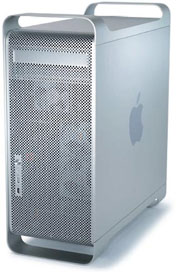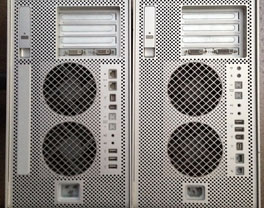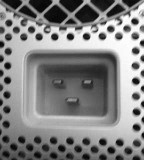Sometimes a computer with a lower GHz rating can outperform one with a higher speed rating, and that’s especially true for the 2.5 GHz Power Mac G5 Quad. One of the first Macs to use IBM’s new dual-core G5 CPUs, the Quad uses a pair of them, which means Power Mac owners now have access to four cores. Not since the Daystar Genesis of 1996 have Mac owners had a four-processor option.
 Each core has 1 MB of level 2 cache, twice as much as earlier G5s, which further boosts computing power. In addition to the 2.5 GHz Quad, Apple also offers 2.0 GHz and 2.3 GHz models with a single dual-core CPU.
Each core has 1 MB of level 2 cache, twice as much as earlier G5s, which further boosts computing power. In addition to the 2.5 GHz Quad, Apple also offers 2.0 GHz and 2.3 GHz models with a single dual-core CPU.
Other improvements include the adoption of PCI Express (PCIe) architecture and a 16-lane Nvidia video card, 533 MHz DDR2 memory, and a 16x dual-layer SuperDrive. This is the first time Apple has included an Nvidia graphics card as a standard feature on its leading-edge model since the Digital Audio Power Mac G4 was introduced in January 2001. There isn’t even an ATI option for this machine.
There’s a small price to pay for this power. The 2.7 GHz Power Mac remains available for those who need PCI-X slots or can’t wait for the Quad to ship in November, but the quad-core 2.5 GHz model is from 20% to 75% faster, according to Apple’s tests.
The motherboard architecture uses HyperTransport technology. System memory is so fast (533 MHz RAM on a 1.25 GHz bus) and the level 2 cache so large that Apple doesn’t bother with a level 3 cache.
A headphone jack, a USB 2.0 port, and a FireWire 400 port are located on the front of the G5 for easy access, and there are three USB ports on the back, up from two on previous G5 Power Macs.
 It’s easier to distinguish the dual-core models from the earlier ones from the back than from the front, as shown in the photo on the left. The Dual and Quad (left) have three USB ports at the bottom of the strip of ports, while earlier models (right) have ethernet and modem at the bottom. There’s also a grey plastic strip on the left side of the dual-core machines.
It’s easier to distinguish the dual-core models from the earlier ones from the back than from the front, as shown in the photo on the left. The Dual and Quad (left) have three USB ports at the bottom of the strip of ports, while earlier models (right) have ethernet and modem at the bottom. There’s also a grey plastic strip on the left side of the dual-core machines.
 One oddity of the dual-core Power Mac G5s is that they use a different power connection, known as IEC320 C19, and don’t work with the standard computer power cable, as show in the photo on the right. These models also use a different power supply than earlier G5 Power Macs, with the Quad using a more powerful one than the Duals.
One oddity of the dual-core Power Mac G5s is that they use a different power connection, known as IEC320 C19, and don’t work with the standard computer power cable, as show in the photo on the right. These models also use a different power supply than earlier G5 Power Macs, with the Quad using a more powerful one than the Duals.
Power Mac G5 Reliability
Reliability ratings are based on statistics compiled by MacInTouch in June 2006, at which time the dual-core Power Mac G5 models had only been on the market for 8 months. Letter grades are based on failure rate: A = 0-6%, B = 7-12%, C = 13-18%, D = 19-24%, and F = 25% or higher. We also note the two components that failed most often.
- G5/2.0 dual-core (Oct. 2005), C- (18%, power supply, logicboard)
- G5/2.3 dual-core (Oct. 2005), C- (18%, power supply, logicboard or optical drive)
- G5/2.5 quad-core (Oct. 2005), C- (17%, logicboard, power supply)
In each generation, except for the final dual-core one, the fastest model is the least reliable, while the second-fastest is the most reliable. Logicboards are the most expensive component to repair, followed by the power supply. Hard drives, optical drives, video cards, and RAM can be replaced inexpensively using third-party components.
- Got a G3, G4, or G5 Power Mac? Join G-List.
- Our Mac OS 9 Group is for those using Mac OS 9, either natively or in Classic Mode.
- Our Tiger Group is for those using Mac OS X 10.4.
- Our Leopard Group is for those using Mac OS X 10.5 and 10.6.
Details
- 2.5 GHz Quad announced 2005.10.19 at $3,299 with November delivery; replaced by 2006 Mac Pro on 2006.08.07
- Identifier: PowerMac11,2
- Order Number: M9592
- Supported Mac OS Versions
- CPU: 2.5 GHz dual-core G5
- Bus: 1.25 GHz (half CPU speed)
- Performance:
- Geekbench 2 (Leopard): 3197
- Geekbench 2 (Tiger): 3298
- RAM: 512 MB, expandable to 16 GB using 533 MHz PC2-4200 DDR2 RAM in 8 slots
- L2 cache: 1 MB on-chip L2 cache per core
- L3 cache: none
- Video: Nvidia GeForce 6600. Nvidia 7800 GT with 256 MB and Nvidia Quadro FX 4500 with 512 MB optional
- VRAM: 256 MB
- Hard drive bus: 1.5 Gbps SATA Rev. 1
- Hard drive: 250 Serial ATA (SATA) 7200 rpm
- Optical drive bus: ATA/100 bus
- optical drive: 16x dual-layer SuperDrive on Ultra ATA/100 bus
- 3 open PCI Express slots: two 4-lane slots, one 8-lane slot
- optional external 56k v.92 modem
- Microphone: standard 3.5mm minijack, compatible with line-level input, not compatible with Apple’s PlainTalk microphone
- FireWire: 2 FW400 ports (1 on front), 1 FW800 port
- USB: 4 USB 2.0 ports (1 on front)
- Ethernet: 2 independent 10/100/gigabit ports
- WiFi: antenna and connector for 802.11g AirPort Extreme card
- Bluetooth: built in, optional antenna
- size (HxWxD): 20.1″ x 8.1″ x 18.7″ (51.1 x 20.6 x 47.5 cm)
- Weight: 44.5-48.8 lb. (20.2-22.1 kg)
- Gestalt ID: n/a
- PRAM battery: 3V CR2032 lithium
- Power supply: 550W part no. 661-3738, requires IEC320 C19 power cord
Accelerators & Upgrades
- none
Online Resources
- Getting the Most from Your Power Mac G5
- What’s the Best Version of OS X for My Mac?, Ian R Campbell, The Sensible Mac, 2008.02.28. Which version of Mac OS X is best for your hardware depends on several factors.
- How Fast Is Classic Mode on a Power Mac G5?, Dan Knight, Mac Daniel, 2014.08.21. We run several benchmark tests from the Classic Mac OS era on a dual 2.3 GHz Power Mac G5 to see how well Classic Mode fares.
- Know Your Mac’s Upgrade Options, Phil Herlihy, The Usefulness Equation, 2008.08.26. Any Mac can be upgraded, but it’s a question of what can be upgraded – RAM, hard drive, video, CPU – and how far it can be upgraded.
- The ‘Better Safe Than Sorry’ Guide to Installing Mac OS X Updates, Charles W Moore, Miscellaneous Ramblings, 2008.12.16. Most users encounter no problems using Software Update, but some preflight work and using the Combo updater means far less chance of trouble.
- Why You Should Partition Your Mac’s Hard Drive, Dan Knight, Mac Musings, 2008.12.11. “At the very least, it makes sense to have a second partition with a bootable version of the Mac OS, so if you have problems with your work partition, you can boot from the ’emergency’ partition to run Disk Utility and other diagnostics.”
- 5 best desktop Macs for gaming for under $1,000, Dan Bashur, Apple, Tech, and Gaming, 2009.09.10. You can have a decently configured gaming Mac for as little as $300 – and the ultimate for under $700.
- The Future of Up-to-Date Browsers for PowerPC Macs, Charles W Moore, Miscellaneous Ramblings, 2009.08.31. With Intel-only “Snow Leopard” shipping, software support for PPC Macs will continue its decline. Also, a look at SeaMonkey 2 and Camino 1.6.9.
- Optimized Software Builds Bring Out the Best in Your Mac, Dan Knight, Low End Mac’s Online Tech Journal, 2009.06.30. Applications compiled for your Mac’s CPU can load more quickly and run faster than ones compiled for universal use.
- Tips for Installing or Reinstalling Mac OS X 10.4 Tiger, Adam Rosen, Adam’s Apple, 2009.06.10. Mac OS X 10.4 uses less memory than Leopard, supports Classic Mode on PowerPC Macs, and, unlike Leopard, is supported on G3 Macs.
- Choosing My Next Low-end Desktop Mac, John Hatchett, Recycled Computing, 2009.05.19. The recently deceased iBook G4 was going to take up desktop duty. Now the options are a G4 iMac, 17″ PowerBook, Power Mac G4, and Power Mac G5.
- PowerPC Architecture Was Not a Failure, Dan Knight, Mac Musings, 2009.02.16. CNET’s Brooke Crothers calls PowerPC a failed architecture, but 12 years of PowerPC Macs, IBM’s blade servers, and three game consoles tell a different story.
- Will Snow Leopard Support Some PowerPC Macs?, Simon Royal, Tech Spectrum, 2008.11.26. It just doesn’t make sense that Apple would ship a new OS that won’t support Macs sold less than three years ago.
- The Long Term Value of a High End Mac, Andrew J Fishkin, Best Tools for the Job, 2008.11.21. Low-end Macs are more affordable up front, but the flexibility and upgrade options of a top-end Mac can make it the better value in the long run.
- Leopard runs very nicely on PowerPC Macs, Simon Royal, Tech Spectrum, 2008.11.19. Some claim that Mac OS X 10.5 is so optimized for Intel Macs that it runs poorly on PowerPC hardware. That’s simply not the case.
- The future of PowerPC Macs and software as ‘Snow Leopard’ approaches, Simon Royal, Tech Spectrum, 2008.11.13. Apple phased out Classic Mode and G3 support with ‘Leopard’ last year, and next year’s OS X 10.6 won’t support any PowerPC Macs. Will other developers abandon PowerPC as well?
- How to clone Mac OS X to a new hard drive, Simon Royal, Tech Spectrum, 2008.10.07. Whether you want to put a bigger, faster drive in your Mac or clone OS X for use in another Mac, here’s the simple process.
- Tiger vs. Leopard: Which is best for you?, Simon Royal, Tech Spectrum, 2008.09.22. Two great versions of Mac OS X, but unless your Mac is well above the minimum spec for Leopard and has lots of RAM, stick with Tiger.
- Apple Trumps Microsoft in Making the 64-bit Transition Transparent to Users, Frank Fox, Stop the Noiz, 2008.09.18. To use more than 4 GB of RAM under Windows, you need a 64-bit PC and the 64-bit version of Windows. On the Mac, OS X 10.4 and later already support it.
- SATA, SATA II, SATA 600, and Product Confusion Fatigue, Frank Fox, Stop the Noiz, 2008.09.08. In addition to the original SATA specification and the current 3 Gb/s specification, SATA revision 3.0 is just around the corner.
- Does running OS X system maintenance routines really do any good?, Charles W Moore, Miscellaneous Ramblings, 2008.08.26. Mac OS X is designed to run certain maintenance routines daily, weekly, and monthly – but can’t if your Mac is off or asleep.
- The Compressed Air Keyboard Repair, Charles W Moore, Miscellaneous Ramblings, 2008.07.24. If your keyboard isn’t working as well as it once did, blasting under the keys with compressed air may be the cure.
- Mac Pro overclocking, Windependence with Darwine, Blu-ray for Macs, and more, Mac News Review, 2008.07.04. Also more on running Leopard on non-Apple hardware, Ubuntu on a Mac mini, the first autofocus webcam with Zeiss optics for Macs, and more.
- PowerPC’s last chance: The Mac’s history with the G5 CPU, Dan Knight, Mac Musings, 2008.06.24. The introduction of the G5 Power Mac in June 2003 promised a bright 3 GHz future, and failure to achieve that paved the way to today’s Intel Macs.
- Snow Leopard and the Death of PowerPC Support, Carl Nygren, Classic Macs in the Intel Age, 2008.06.23. It looks like Mac OS X 10.6 will only support Intel Macs – and possibly only 64-bit ones at that. Should G4 and G5 owners start looking at Linux?
- Virtual PC works with Leopard, Intel vs. PowerPC performance, beyond the Mac mini, and more, Dan Knight, Low End Mac Mailbag, 2008.05.20. Also upgrading Intel iMacs, Compact Flash in a PowerBook 2400, and thoughts on low-end Macs.
- Power Mac G5 vs. Intel Mac mini, video thumbnails lost in migration, OCR software, and more, Dan Knight, Low End Mac Mailbag, 2008.03.17. Also HARMONi compatibility with Mac OS X 10.4, a dual processor G4 auction, Internet access by digital phone, and more.
- 2.6 GHz MacBook Pro worth it?, iBook video fixed, Compact Flash vs. SSD, and more, Dan Knight, Low End Mac Mailbag, 2008.03.13. Also buying a used Power Mac G4, a Power Mac 7600 still in daily use, OCR software for modern Macs, and Leopard on a Blue and White G3.
- Leopard on a Cube, G4 CPU swap limitations, Power Mac G5 a good choice?, and more, Dan Knight, Low End Mac Mailbag, 2008.03.06. Also looking for a scanner that works with Panther and the hsitory of expansion slots in low-cost Macs.
- Safari 3.1 will be ‘crazy fast’, OS X 10.5.2 update, 20x SuperDrive from $35, and more, Mac News Review, 2008.02.15. Also Security Update for Tiger, Graphics Update for Leopard, Mac mini “as powerful as a larger desktop”, TechTool Deluxe update, and more.
- Restore stability to a troubled Mac with a clean system install, Keith Winston, Linux to Mac, 2008.01.15. If your Mac is misbehaving, the best fix just might be a fresh reinstallation of Mac OS X – don’t forget to backup first.
- Leopard pales before Mac OS 8.5 for Macs left behind, dual processor benefits, and more, Dan Knight, Low End Mac Mailbag, 2007.10.23. Mac users may not remember that Mac OS 8.5 left behind some Macs just over two years old. Compared to that, Leopard users have it made.
- 11 No Cost Tips for Optimizing Mac OS X 10.4 Tiger Performance, Ed Eubanks Jr, The Efficient Mac User, 2007.03.12. If your Mac is getting sluggish, here are 11 tips that can help restore its original performance.
- Mac market up 34.6%, Core 2 minis?, red mice and iPods, a $30 Bluetooth 2.0 dongle, and more, Mac News Review, 2006.11.10. Also Apple’s repair extension program for dual-core G5 PowerMacs.
- Radeon X1900 for Power Mac G5, DVD-RAM benefits, Spin Doctor 2 digitizes LPs and tapes, and more, Mac News Review, 2006.11.03. Also Mac Pro hard drive speed and expandability, Mac T-shirts, dual digital TV tuner for Macs, WiFi signal analysis, another Boot Camp update, and a hot-swap RAID enclosure.
- Region Free DVD Viewing Options for Intel and PowerPC Macs, Andrew J Fishkin, The Mobile Mac, 2006.09.12. Several hardware and software options that will let your view ‘wrong region’ DVDs on your PowerPC or Intel Mac.
- Power Mac G5 Reliability, Robert Mohns, Macintouch, 2006.07.06. On average, 17% of Power Mac G5 units require repair within their first year of use. That drops to 9% for the second year.
- Macs take away Microsoft pain, Macs revive James Bond, iMac king of all media, iWoofer, and more, Mac News Review, 2006.06.16. Also Windows users guide to switching to the Mac, Bluetooth firmware update for PPC Macs, universal USB 2.0 drive adapter, waterproof case for video iPod, and more.
- Drive matters, Dan Knight, Mac Musings, 2006.06.14. There’s more to picking the right hard drive than size, spindle speed, buffer size, and price. But how can a 5400 rpm drive ever outperform a 7200 rpm drive?
- Power Mac today or Intel tomorrow?, Nvu shortcomings, and best way to sell older Mac stuff, Dan Knight, Low End Mac Mailbag, 2006.05.24. Thoughts on buying a Power Mac G5 now or waiting for the Intel replacement, problems with Nvu software, and how to get the best price when selling old Mac stuff.
- The Aperture 1.1 update fiasco: Stock Power Mac G5 Dual and Quad video no longer recommended, Dan Knight, Mac Musings, 2006.05.18. “The normal configuration of Apple’s three current Power Mac models includes Nvidia GeForce 6600 graphics, the original version of Aperture supported it, but with the update it’s no longer recommended.”
- World gone Apple crazy, voice recognition on Intel Mac mini, 705 GB Seagate drive, 4-drive RAID hardware, and more, Mac News Review, 2006.04.28. Also why the Mac version of America’s Army has been dropped, using DVD-RAM with OS X, and a new 2-port serial ATA PCI Express card for the latest G5s.
- The October 2005 Power Mac G5 value equation, Dan Knight, Mac Musings, 2005.10.21. The newest Power Macs have dual-core CPUs, but how does value compare with the discontinued models?
- Apple Specs: Power Macintosh G5 (Late 2005)
Keywords: #powermacg5
Short link: http://goo.gl/X0MA1x
searchword: late2005powermacg5quad

